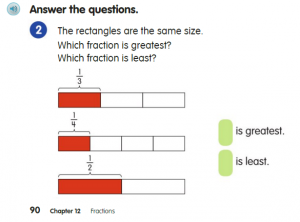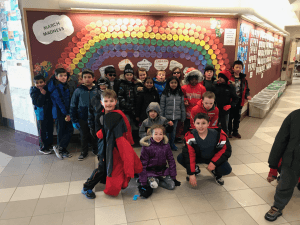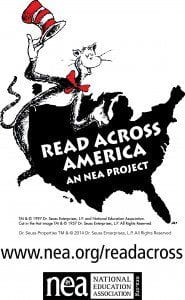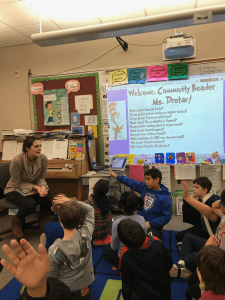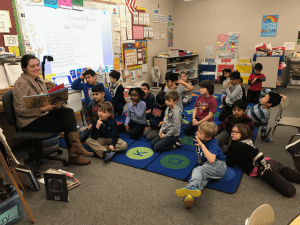Posted by kavery508 | Posted in Uncategorized | Posted on March 25, 2019
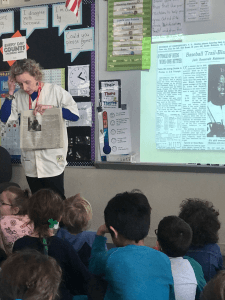 Students were treated to a visit from local children’s author, April Jones Prince! Ms. Prince shared with students the journey it takes to publish your own writing, from brainstorming, to revising, to the all-important skill of editing. The kids were highly engaged and asked many great questions. Thanks to our PTO for funding this enriching opportunity!
Students were treated to a visit from local children’s author, April Jones Prince! Ms. Prince shared with students the journey it takes to publish your own writing, from brainstorming, to revising, to the all-important skill of editing. The kids were highly engaged and asked many great questions. Thanks to our PTO for funding this enriching opportunity!
 This is last call for Literacy Night readers! If you child wishes to read an original piece of writing, please let me know today. All permission forms are due no later than this Wednesday, March 27.
This is last call for Literacy Night readers! If you child wishes to read an original piece of writing, please let me know today. All permission forms are due no later than this Wednesday, March 27.
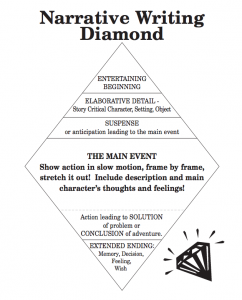 Our work with narrative writing has paid off! Here are some great examples of stories from 1) Ari on going sledding, 2) Mohan on building a leprechaun trap, and 3) Yash on having a snowball fight. Note how they stretch out the action with details and a good sense of author’s voice: 1) Should we build a snowman? Should we have a snowball fight? And then right as we were thinking, it hit me! Let’s go sledding. 2) I started first with the cardboard box. I had to cut out 49 x 6 inches, so I used my mom’s measuring tape. Then, I was snipping off cardboard like I was the greatest tailor! 3) We both raced to my front yard and started building rectangle walls made out of pure, cold ice. I made a hole in the roof so we could throw snowballs from the top. Once we finished the fort, we started crafting snowballs. Awesome!
Our work with narrative writing has paid off! Here are some great examples of stories from 1) Ari on going sledding, 2) Mohan on building a leprechaun trap, and 3) Yash on having a snowball fight. Note how they stretch out the action with details and a good sense of author’s voice: 1) Should we build a snowman? Should we have a snowball fight? And then right as we were thinking, it hit me! Let’s go sledding. 2) I started first with the cardboard box. I had to cut out 49 x 6 inches, so I used my mom’s measuring tape. Then, I was snipping off cardboard like I was the greatest tailor! 3) We both raced to my front yard and started building rectangle walls made out of pure, cold ice. I made a hole in the roof so we could throw snowballs from the top. Once we finished the fort, we started crafting snowballs. Awesome!
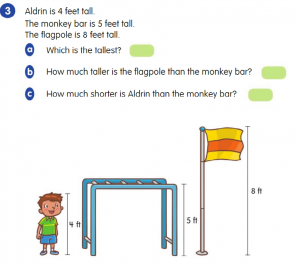
Our next math topic for exploration involves standard units of measurement. Students will engage in hands-on activities to develop a sense of how big one foot and one inch are. They will learn to compare heights and lengths in standard units, and use their knowledge to solve real-world problems about measurement. Consider the picture above. Notice how it encompasses all three big ideas? Now think: how would you find the answers using bar models as well? There are vocabulary and picture resources added to math homework folders to help at home.
 The final science topic of the year that we will explore is States of Matter. Through a combination of hands-on activities, investigations meant to teach the scientific process of inquiry, and multimedia approaches, students should develop an understanding of matter and be able to identify solids, liquids, and gases by their observable properties. This week they will investigate solids, liquids, and gels by manipulating examples of each in order to learn about their properties. Here’s a link to our district’s science program for this topic, with objectives and content defined:https://www.fossweb.com/delegate/ssi-wdf-ucm-webContent?dDocName=D568667
The final science topic of the year that we will explore is States of Matter. Through a combination of hands-on activities, investigations meant to teach the scientific process of inquiry, and multimedia approaches, students should develop an understanding of matter and be able to identify solids, liquids, and gases by their observable properties. This week they will investigate solids, liquids, and gels by manipulating examples of each in order to learn about their properties. Here’s a link to our district’s science program for this topic, with objectives and content defined:https://www.fossweb.com/delegate/ssi-wdf-ucm-webContent?dDocName=D568667

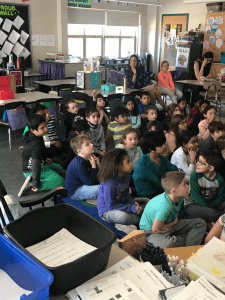

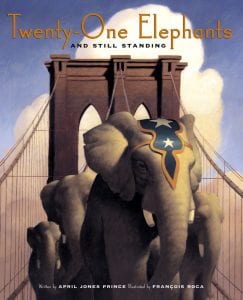
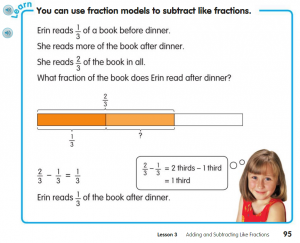

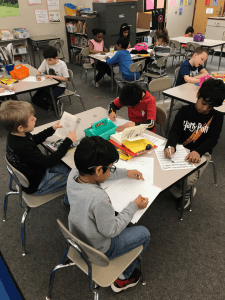
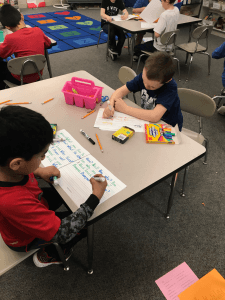

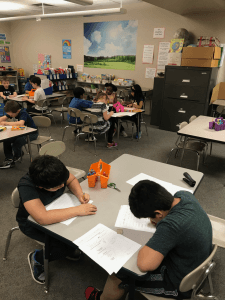
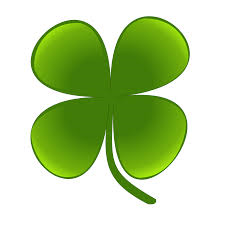 Luck o’ the Irish? There’s just 13 weeks left in the school year! We’ll start this one by flexing our map skills as we explore directionality and landforms related to the Emerald Isle, share Irish folk tales and music, and more. For some fun sharing of Irish culture, check out:
Luck o’ the Irish? There’s just 13 weeks left in the school year! We’ll start this one by flexing our map skills as we explore directionality and landforms related to the Emerald Isle, share Irish folk tales and music, and more. For some fun sharing of Irish culture, check out: 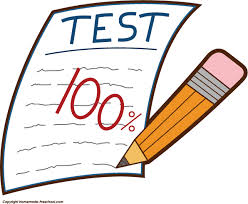

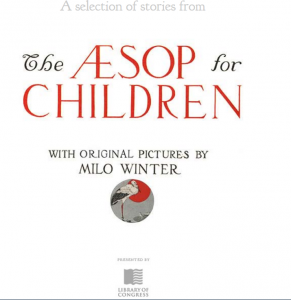
 In our final trimester, students will engage in short, skills-based math units on topics such as telling time, measuring in inches/feet, graphing, and more. We begin by learning fractions: what they are; how to name them; how to compare them, and how to add fractions with similar denominators. What’s important, according to the Common Core, is that students gain an understanding of what fractions mean and become fluent using halves, thirds, and fourths. Consider the example below. Notice how it encourages students to think about what fractions are and about their relative sizes. This picture and many more can be found in the Student Book accessible via the Math in Focus link above (Book B; Chapter 12). As always, hit me with any questions!
In our final trimester, students will engage in short, skills-based math units on topics such as telling time, measuring in inches/feet, graphing, and more. We begin by learning fractions: what they are; how to name them; how to compare them, and how to add fractions with similar denominators. What’s important, according to the Common Core, is that students gain an understanding of what fractions mean and become fluent using halves, thirds, and fourths. Consider the example below. Notice how it encourages students to think about what fractions are and about their relative sizes. This picture and many more can be found in the Student Book accessible via the Math in Focus link above (Book B; Chapter 12). As always, hit me with any questions!